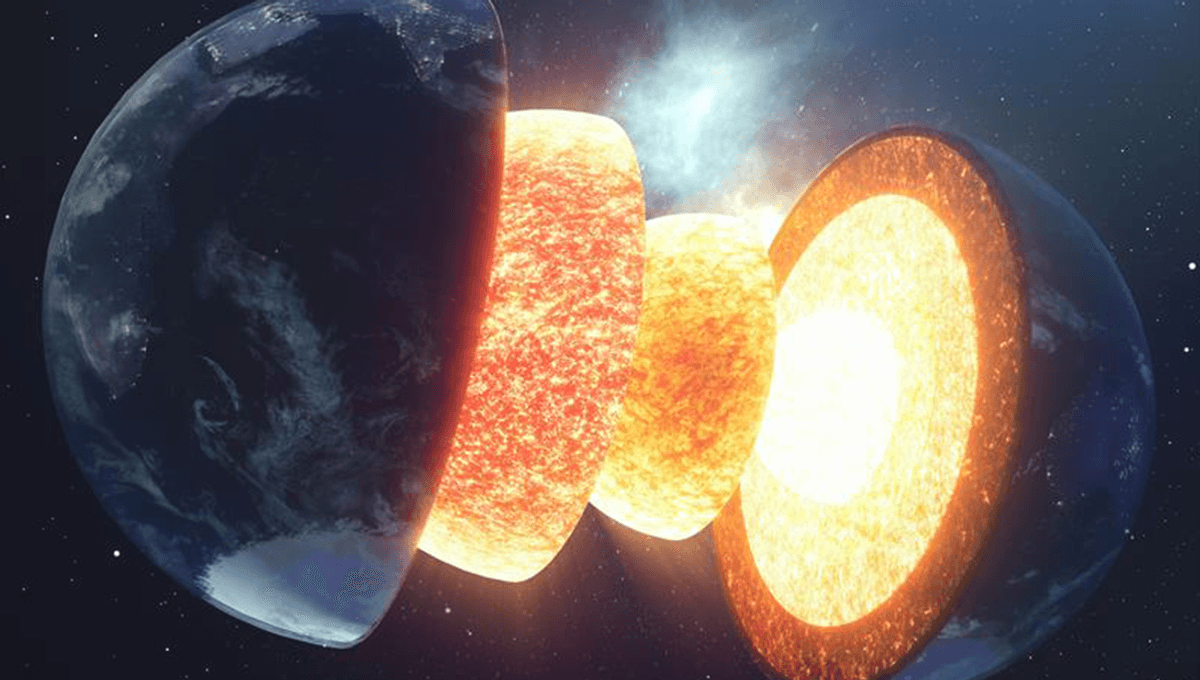
As much as we have explored and modeled our planet, there are a number of mysteries that surround the Earth’s inner core.
This isn’t that surprising, as it’s pretty difficult to study a region over 5,100 kilometers (3,170 miles) beneath our feet, when the furthest we have physically drilled into the Earth is a measly 12,263 meters (40,230 feet). But we can learn about the center through looking at seismic waves traveling through the Earth, as well as the magnetic field lines of the planet, the result of conditions in the core.
One mystery we haven’t solved yet is how the core has “frozen” solid from a molten liquid state in its past.
“The Earth’s inner core was once liquid, but has turned solid over time. As the Earth gradually cools, the inner core expands outwards [as] the surrounding iron-rich liquid ‘freezes’. That said, it is still extremely hot, at least 5,000 Kelvin (K) (4,726.85°C),” Alfred Wilson-Spencer, research fellow of Mineral Physics at the University of Leeds and lead author of a new study, wrote in a piece for The Conversation.
Discovering how this process took place could help us understand the Earth’s magnetic fields, which given the magnetosphere’s role in protecting the Earth from harmful solar radiation, could in turn help us understand the conditions necessary for life to thrive.
“This process of freezing releases elements, such as oxygen and carbon, which aren’t compatible with being in a hot solid. It creates a hot, buoyant liquid at the bottom of the outer core. The liquid rises into the liquid outer core and mixes with it, which creates electric currents (through ‘dynamo action’), which generates our magnetic field,” Wilson-Spencer said.
How the Earth’s core “froze” is difficult to figure out, given our location on Earth and in time, with the cooling taking place over a billion years or longer.
“The traditional view of inner core growth is that the temperature at the centre of the Earth declined until it reached the melting temperature of the constituent liquid iron alloy, at which point freezing of the inner core began,” the team explain in their paper. “However, this picture is incomplete because it ignores the physical requirement that all liquids must be supercooled by [a significant] amount […] below the melting temperature before solids can nucleate without remelting.”
Previous models suggest that in order for the core to “freeze” in a ~1 billion year timeframe, the liquid iron (and other minerals in far smaller abundances) would need to be supercooled by around 700-1,000 Kelvin. But this presents some problems.
“If the core was supercooled by 1,000K before freezing, the inner core should be much larger than observed,” Wilson-Spencer explained. “Alternatively, if 1,000K is necessary for freezing and was never achieved, the inner core should not exist at all.”
In the study, which has not yet been peer-reviewed, the team looked at how the presence of other elements in the core could affect its supercooling, simulating the interactions of iron and carbon atoms under intense pressure using a supercomputer. With carbon present, the team found that the core could cool and solidify with far less supercooling, perhaps under 400K, and in plausible timescales.
Further study is of course needed, and the idea could be complicated further by the presence of other elements in the core, such as oxygen and silicon. However, it is an interesting avenue to explore, and may raise further questions about the heart of our planet.
“The implications of not understanding the formation of the inner core are far-reaching. Previous estimates of the inner core’s age range from 500 to 1,000 million years. But these do not account for the supercooling issue,” Wilson-Spencer added. “Even a modest supercooling of 100K could mean the inner core is several hundred million years younger than previously thought.”
The study is posted to preprint server EarthArXiv, and has not yet been peer-reviewed.
Source Link: What Caused The Earth's Inner Core To Freeze?